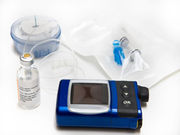Smoother average 24-hour glucose profile with Gla-300 versus Gla-100, regardless of injection time
TUESDAY, Jan. 31, 2017 (HealthDay News) — For patients with type 1 diabetes, receipt of insulin glargine 300 U/mL (Gla-300) is associated with better glucose control than glargine 100 U/mL (Gla-100), regardless of injection time, according to a study published online Jan. 23 in Diabetes Care.
Richard M. Bergenstal, M.D., from the International Diabetes Center at Park Nicollet in Minneapolis, and colleagues conducted a 16-week trial involving 59 adult patients with type 1 diabetes. Participants were randomized to once-daily Gla-300 or Gla-100 given in the morning or evening in a 1:1:1:1 ratio.
The researchers found that between the Gla-300 and Gla-100 groups, the percentage of time within the target glucose range, as measured using continuous glucose monitoring (CGM), was comparable. The CGM-based glucose increased significantly less during the last four hours of the 24-hour injection interval for Gla-300 versus Gla-100 (least squares mean difference −14.7 mg/dL). Irrespective of morning or evening injection, the mean 24-hour glucose curves were smoother for the Gla-300 group. No difference was seen between Gla-300 and Gla-100 in four metrics of intra-subject interstitial glucose variability. Gla-300 participants had lower nocturnal confirmed or severe hypoglycemia rate than for Gla-100 participants (4.0 versus 9.0 events per participant-year, rate ratio, 0.45).
“Less increase in CGM-based glucose levels in the last four hours of the 24-hour injection interval, smoother average 24-hour glucose profiles irrespective of injection time, and reduced nocturnal hypoglycemia were observed with Gla-300 versus Gla-100,” the authors write.
Several authors disclosed financial ties to pharmaceutical companies, including Sanofi, which funded the study.
Full Text (subscription or payment may be required)
Copyright © 2017 HealthDay. All rights reserved.








